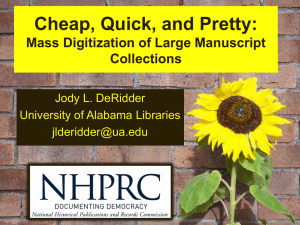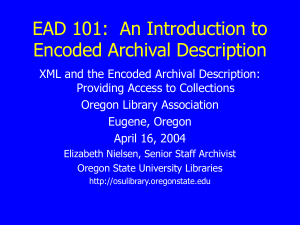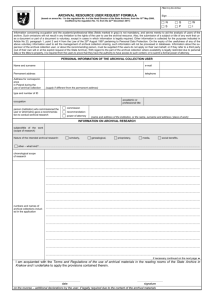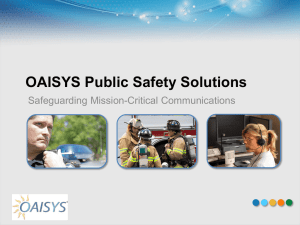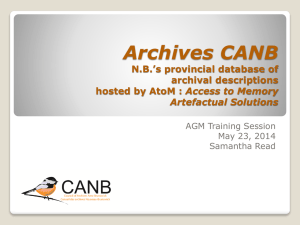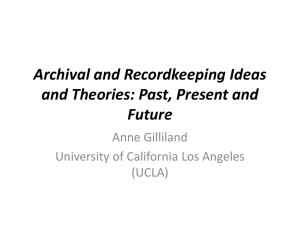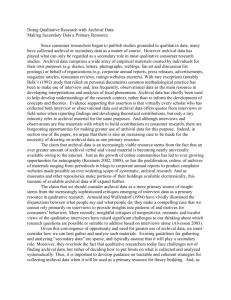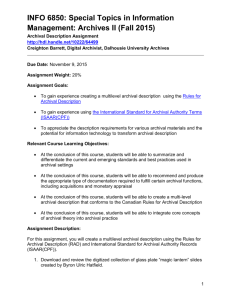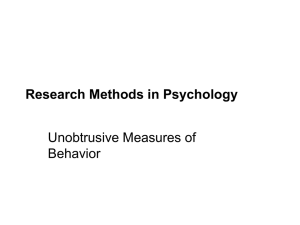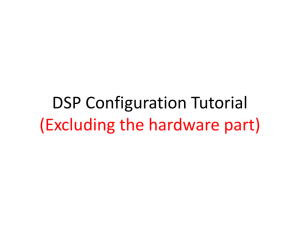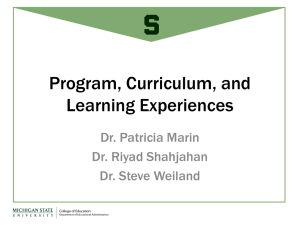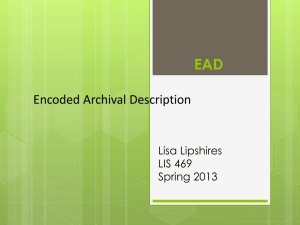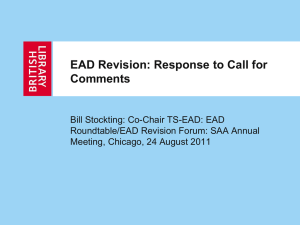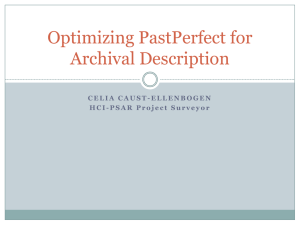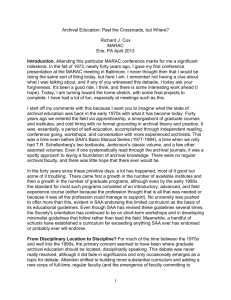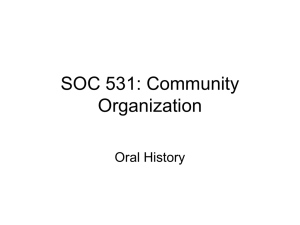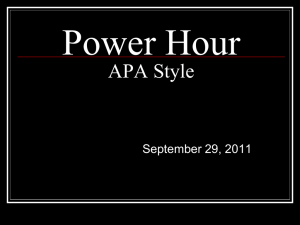Providing Access to Digitized Content Via the
advertisement
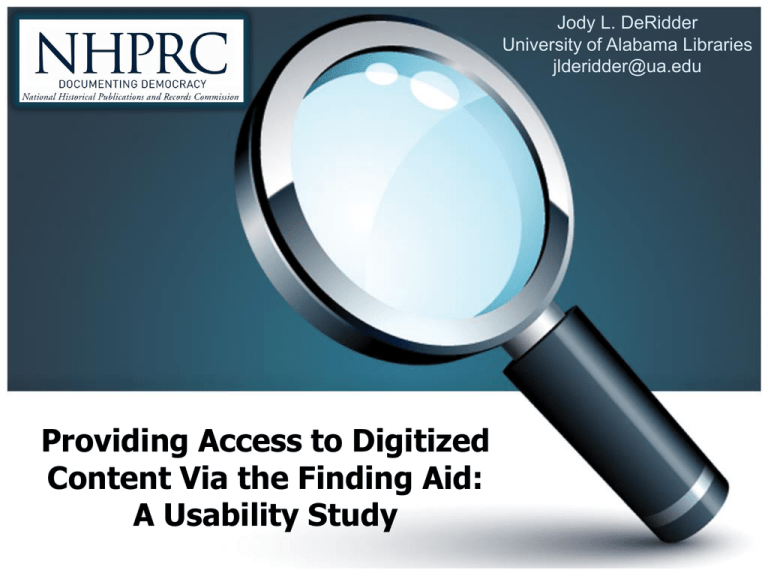
Jody L. DeRidder University of Alabama Libraries jlderidder@ua.edu Providing Access to Digitized Content Via the Finding Aid: A Usability Study Delivery Via Finding Aid Problem statement: How usable is this?? Methodology Efficiency: Time on task, number of clicks Effectiveness: Successful task completion Satisfaction: Ranking of perceived difficulty and positive vs. negative comments Learnability: Improvement in time, clicks, and success over 4 tasks in a single session Participants Participant Number Educational Status* Educational Background in History Previous Special Collections Experience Previous Digital Collections Experience English as a Second Language 1 2 3 4 5 6 7 8 9 11 12 13 14 15 16 17 18 19 20 21 G G U G G G S G U G U U U U U U PG G G G X X X X X X X X X X X X X X X X X X X * U=Undergraduate, G=Graduate Student, PG=Post graduate volunteer, S=University staff X X X X X X X X X X X X X X X X X X X X Procedure Task 1: Task 2 : Task 3: Task 4 : Locate a piece of legal correspondence. Locate an estate document. Locate some kind of deed. Locate a family history document or some other family item. Results: Efficiency, Effectiveness, Satisfaction of item-level described content, compared to finding aid access: Efficiency: 35% less time, 48% fewer clicks Not surprising: finding aid provides more context. Effectiveness: Success rates 7.5% higher Not surprising: no EAD search function or navigation box. Satisfaction: Preferred by a ratio of 3:1 Not surprising: these are novice users. Notable Comparison Between Participants English as a second language Difficulty with both interfaces! • 51% more time and 10% less success in the item-level interface • 41% more time and 13% less success in the finding aid interface • 80% preferred the item-level interface No previous experience with digital collections: Found finding aid interface significantly easier than those with digital collection experience! • 42% less time • 27% fewer clicks • 12% more success Results: Learnability Paired-sample t- test comparing task 1 to task 4: Paired Differences 95% Confidence Interval of the Difference Mean Pair 1 FirstClickJem1 - Std. Deviation Std. Error Mean Lower Upper t df Sig. (2-tailed) -.39286 3.30605 .88358 -2.30171 1.51600 -.445 13 .664 .00000 2.44949 .65465 -1.41429 1.41429 .000 13 1.000 FirstClickJem4 Pair 2 FirstClickCab1 FirstClickCab4 Pair 3 TotClickJem1 - TotClickJem4 .714 2.813 .752 -.910 2.338 .950 13 .359 Pair 4 TotClickCab1 - TotClickCab4 -1.071 8.713 2.329 -6.102 3.959 -.460 13 .653 Pair 5 TotTimeJem1 - TotTimeJem4 2.143 13.061 3.491 -5.398 9.684 .614 13 .550 Pair 6 TotTimeCab1 - TotTimeCab4 5.786 44.295 11.838 -19.789 31.361 .489 13 .633 Pair 8 EffectCab1 - EffectCab4 -.14286 .53452 .14286 -.45148 .16577 -1.000 13 .336 No significant differences Further Research Indicated More tests on the finding aid interface to determine what actually improves usability. Suggestions from the research include: • replacing archival terminology • Providing search in page feature • Providing navigation links for sections of the finding aid on the left THEN: learnability tests for novice users that span multiple sessions. Conclusions Don’t compare item level access to finding aid access; they aren’t comparable. Find ways to make the EAD more user-friendly. EAD delivery works for us; let’s make it work for our users! Certain images and/or photos on this page are the copyrighted property of 123RF Limited, its Contributors or Licensed Partners and are being used with permission under license. These images and/or photos may not be copied or downloaded without permission from 123RF Limited. References Joyce Celeste Chapman, “Observing Users: An Empirical Analysis of User Interaction with Online Finding Aids,” Journal of Archival Organization 8, no. 1 (2010) http://dx.doi.org/10.1080/15332748.2010.484361 Cory Nimer and J. Gordon Daines III, “What Do You Mean It Doesn’t Make Sense? Redesigning Finding Aids from the User’s Perspective,” Journal of Archival Organization 6, no. 4 (2008), http://dx.doi.org/10.1080/15332740802533214 Wendy Scheir, “First Entry: Report on a Qualitative Exploratory Study of Novice User Experience with Online Finding Aids,” Journal of Archival Organization 3, no. 4 (2006), http://dx.doi.org/10.1300/J201v03n04_04 Tom Tullis and Bill Albert, Measuring the User Expereience: Collecting, Analyzing, and Presenting Usability Metrics (Burlington, MA: Morgan Kaufmann, 2008, 92-94. Tim West, Kirill Fesenko, and Laura Clark Brown, “Extending the Reach of Southern Sources: Proceeding to Large-Scale Digitization of Manuscript Collections,” Final Grant Report for the Andrew W. Mellon Foundation, Southern Historical Collection, University Library, University of North Carolina at Chapel Hill, June 2009, http://www.lib.unc.edu/mss/archivalmassdigitization/download/extending_the_reach.pdf Elizabeth Yakel, “Encoded Archival Description: Are Finding Aids Boundary Spanners or Barriers for Users?” Journal of Archival Organization 2, no. 1 & 2 (2004), http://dx.doi.org/10.1300/J201v02n01_06. For more information: …upcoming American Archivist article? • University of Alabama Libraries, “Septimus D. Cabaniss Papers Digitization Project.” Project Site: http://www.lib.ua.edu/libraries/hoole/cabaniss Wiki: http://www.lib.ua.edu/wiki/digcoll/index.php/Cabaniss Display: http://acumen.lib.ua.edu/u0003_0000252
